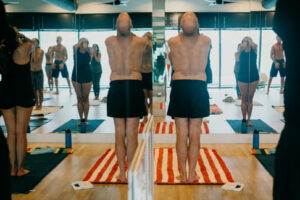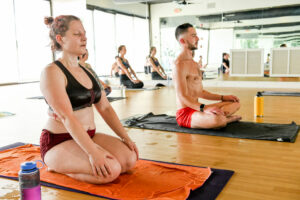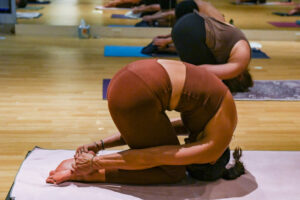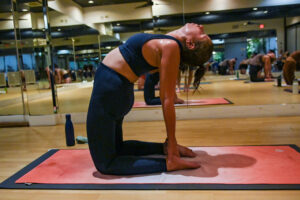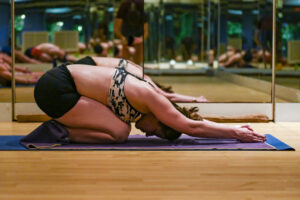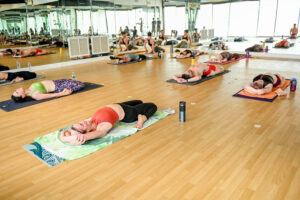Pranayama. This is how we begin each 26 & 2 Hot Yoga class. Prana: life force + Yama: control. We start by bringing conscious control to our life force with the breath. During pranayama, we take the time to connect our minds to our bodies and bring stability to our practice.
When your prana or life force is blocked, our yogis tell us you can experience a lack of focus and negative emotions.
Some people might think of this as a bit woo-woo…connecting to our life force. But don’t you love it when what you feel in your heart and in your body gets a nod from science?
If that’s a yes, you’re in for a real treat.
Drop me down to the science now.
How do you correctly perform Pranayama?
The pranayama we use to start our 26 & 2 hot yoga classes uses a sama vritti pranayama. That means equal breath. In other words, the inhale is equal to the exhale. So, let’s talk specifics.
The inhale
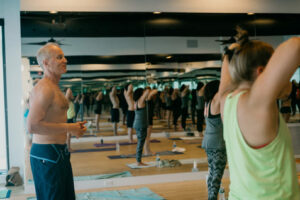
For beginners, this inhale can feel interminably long. You’re keeping your mouth closed while trying to breathe in 110 degrees, after all.
That takes a TON of concentration! Even for advanced yogis. Which is really the point.
This is the first pose of your practice. And you are requiring your mind to be still, present, and focused.
While you’re breathing in for 6 seconds, you’re also keeping your spine straight, tucking your tailbone, and tightening your core. This allows you to fill your lungs with your inhale to full capacity.
The exhale
From the beginning of the breath, you want to keep your abs tight. This allows you to fully expand the lungs into your back on your inhale. And it also allows you to completely empty the lungs on the exhale.
As an aside, did you know we actually exhale and sweat out our fat, and that’s how we maintain or lose weight? I’m including two fun links to learn more about the science behind this. How Breathing and Metabolism are Connected
Metabolomics, NAD+, and Cancer Metabolism
So, let’s get that fat out by opening your mouth and fully emptying your lungs while you move the top of your head toward the wall behind you and pull your elbows tight together your hands clasped beneath your chin.
For beginners, this can really start to feel awkward. And there’s an automatic tendency to close your eyes as you start to move your head back. But this is the time to stay alert. You want to keep those eyes open as you move your head back.
When was the last time you stretched up and naturally reached the top of your head to the wall behind you? Ever tried to fully exhale in that position? Ever tried doing both of those things at the same time?
For our newbies, we simply ask that you stick with it a few times. You’ll get a ton of physical and mental benefits from this one posture, even if it feels awkward the first time.
What will you feel as you practice pranayama?
And speaking of feeling awkward…how is it supposed to feel?
Well, awkward. But pranayama is not to be confused with the awkward pose, which we’ll cover on a later date.
What you should feel in your body.
Pranayama can give you all kinds of feels. But let’s start with what you should feel in your body.
I remember the first time I experienced pranayama in my 26 & 2 hot yoga class. I felt a pinch in my neck and tightness in my shoulders. I heard a lot of cracking too. It was like places in my body were waking up for the first time.
I also struggled to exhale for the full 6 counts with each breath. And that was followed by a burning in my throat and lungs as I gulped as much of an inhale as I could through my nose when it was time to start that again.
My first thought was, I wonder how many of these breaths we’re going to have to do! This doesn’t feel great.
And guess what? That was all very normal. That’s how pranayama can feel in your body, especially if you’re a beginner.
If you’ve attended hot yoga, and you’re wondering if there are any benefits to sticking with it, read this article on the health benefits of building perseverance by hanging in there.
How pranayama should feel in your mind.
Sometimes yogis talk about Pranayama as the start of your yoga class. But don’t forget, your class starts when you enter the studio.
If you’re wondering how we think you should start your yoga practice, read our article here about why we set intentions for our practice.
I mention setting intentions because that’s the beginning of focusing the mind. And Pranayama helps cement your focus.
For sure when I was starting out, Pranayama felt a bit like a mental fight. I was fighting to stay in the hot room. I was fighting to stay focused on each movement. The fight continued as I awakened parts of my body that weren’t used to moving, at least not in that way. And I was fighting to fully use my lungs.
Fun fact: Most of the day we only inhale using about 10% of our lungs. It takes a lot of concentration to fully use and increase our lung capacity.
The discomfort caused me some mental frustration…until the day that it didn’t. And what a breakthrough that was!
There was a turning point for me in my pranayama journey that my mind started to feel awake, focused, relieved. Instead of feeling frustrated, I felt mental tension flowing out of me as I exhaled. And I felt ready to embrace my next posture.
If you’re thinking, yeah right. I don’t blame you. But consider the “runner’s high.” I think it’s a similar thing. You have to experience it to fully believe it. So, stick with your practice, and let me know when Pranayama starts to feel like a release for you!
But what about the science of Pranayama?
Listing all the science-proven benefits of Pranayama would take us several articles to cover well. So, we’ll highlight a few of our current favorites.
Wave Goodbye to ADHD
Let’s talk brainwaves. Specifically, alpha waves. EEGs of participants over multiple studies showed an increase in alpha brain waves and a decrease in theta waves during and after equal breath, slow breathing exercises. Now, what does that even mean?
Well, people (and kids especially) with learning disabilities and ADHD appear to have a deficit of Alpha waves. And that leads to increased anxiety, decreased focus, and higher rates of emotional outbursts.
Theta waves are responsible for daydreaming and fantasizing. Theta waves are not normally seen in adults during their wakeful hours. However, when these are recorded on EEGs, they are usually correlated with behavioral inhibition and anxiety.
Read more about the types of brain waves and their functions here.
Bottom line? It seems our breathing exercise is related to outcomes that increase focus, lower anxiety, and help us control our behaviors. While that might not cure ADHD, it can certainly give our brains some power to fight it.
Weight Lifting for Your Lungs
In 2019, the Journal of Clinical and Diagnostic Research published an article on the effects of Pranayama on the lungs.pdf). What they found was a statistically significant increase in all measures of lung performance. Meaning, you can actually strengthen your lungs so that they work better for you.
Because they tested the functions that are often tested in diagnosing asthma, pneumonia, and bronchitis, the researchers suggest Pranayama can help your lungs recover from these conditions.
In light of what’s happened the past couple of years, we likely could all use improved lung capacity.
See ya, Sleep Apnea!
The European Respiratory Journal published a study in 2019 showing a significant correlation between practicing Pranayama and reduced snoring, daytime sleepiness, and reduced sleep apnea. Research connects sleep apnea to all kinds of diseases and illnesses. So, that’s totally worth practicing to me. But I’m betting some people would pay a LOT of money for a little less snoring in the bedroom at night. So, maybe slip your favorite bed fellow a yoga pass you’ll both enjoy. 😉
Reduce Tension AND Hypertension
Looking at the numbers in last week’s article about artherosclerosis, we might all have a hypertension problem. But the National LIbrary of Medicine published a study that concluded Pranayama can reduce blood pressure in hypertensives.
We already learned how the breathing exercise reduced tension and induced relaxation. And it seems to have a similar outcome on our vascular system.
The researchers conclude that Pranayama allows our parasympathetic activity to override our sympathetic activity. And that means their blood pressure remained steady even in moments when their stress, anger, and anxiety increased.
What could a full practice do for you?
If one posture in our 26 & 2 yoga practice can give you all these benefits, what could a full class do for you? Come practice with us for 30 days, and you won’t need a science paper to tell you it works. You’ll experience all the benefits for yourself. What would that be worth to you?
 -ing our NEW! Community Classes!
-ing our NEW! Community Classes!